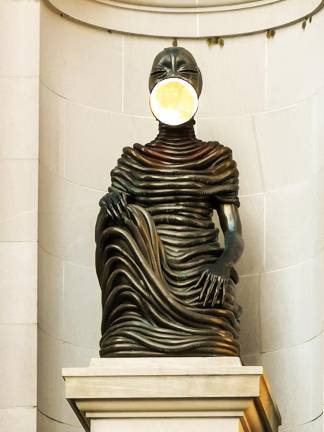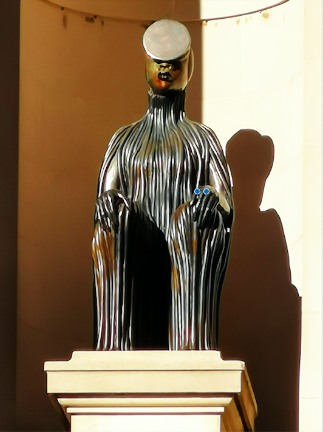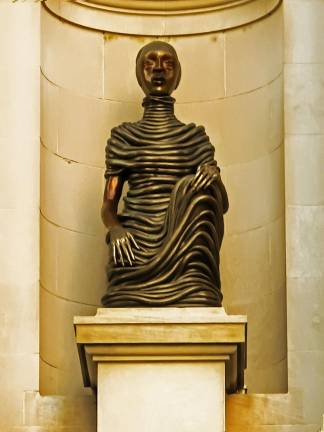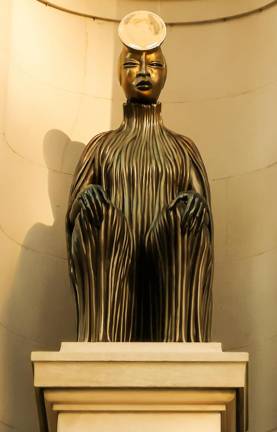People who know the Metropolitan Museum of Art well have probably at one time or another noticed the carved niches around the entrance, which, until now, have been empty. Some of them may have glanced higher and spotted the sculpted roundels that run across the lintel of the entrance. Plaques depict Bramante, Dürer, Michelangelo, Raphael, Rembrandt and Velazquez , all greats – all European male artists of the past.
Now, during Women's History Month, is a perfect time to head to The Met and witness a paradigm shift. "Wangechi Mutu, The NewOnes, will free Us" is the museum's first façade commission and the first time Richard Morris Hunt's sculptural niches, completed 117 years ago, have been filled. (New works will be commissioned annually.)
Feminine. Commanding. Historic. Contemporary. Specific. Universal. Freeing. Free. All of these and more come together in Mutu 's monumental, majestic figures which now flank The Met's front door.
Through the Lens of Womanhood
A Kenyan-American artist, Mutu has been working and exhibiting in New York for years. She's known for her paintings, collages, film and performance art and addresses themes of self-image, gender, race, environmentalism, and equality, often through the lens of womanhood. But she has never had a stage like Fifth Avenue, on the front of The Met.
Mutu's suite of sculptures comprises four female figures titled "The Seated I-IV." Made of bronze, yet covered with ropy forms that recall hand-built pottery, and colored by a rich, though recent, patina, they are simultaneously elegant, abstract, modern, timeless, human and otherworldly. "I want these figures to appear to have come from elsewhere, from afar, recently alighted in the four niches," writes Mutu in her artist's statement. "They have come to look and bear witness, and to reflect back to us what we are. Amid the deep existential crisis we are immersed in, The Seated — conveying a presence that is as much celestial as it is deeply human — aim to send a signal that things can and shall be different."
Hope for Decency, and Triumph Over Prejudice
Mutu fashioned her sculptures after caryatids, decorative structures that have been incorporated into weight bearing devices from wooden stools and headrests in Africa to marble friezes in ancient Greece, and which historically take the shape of female figures with uplifted arms.
"I look at the contradictory aspects of such human expressions, in which women are respected for their strength, resilience, and wisdom and yet suffer for it, too," Mutu states. Her figures have been liberated from the role of carrying the weight of others. She has them sit, tall and regal, their arms resting comfortably on their knees.
Part of the artistic challenge of the commission was to relate new pieces to works in the collection. Coils of metal that envelop Mutu's women reference both armor and rings of necklaces, like those worn by Ndebele and Padoung people, and as seen in The Met's galleries. Polished round disks recall lip plates. They obscure the figures' faces while reflecting the viewers'. In certain light, they shine like directional beacons.
"These insignia in The Seated, belonging to no one place or time, become dimension-bending tools and time-traveling mechanisms," Mutu states. "The mirror-like disks are instruments that trigger reflection and beckon futures in which there is hope for decency and empathy, and triumph over inequality and prejudice." Sheena Wagstaff, chairman of modern and contemporary art, called Mutu's "NewOnes" "marvelous hybrids of African sculpture and futuristic imagination."
More Voices in the Hallowed Halls
The façade commission is part of The Met's push to engage more actively with contemporary art – a move heralded by opening galleries in the Breuer building several years ago and by the hire of director Max Hollein in 2018. His multi-disciplinary vision has brought more voices, like Mutu's, to the hallowed halls of the Met, and placed contemporary art in dialogue with other cultures. It also ties in to a much wider movement in the arts to become more representative of a varied and diverse society.
"I titled the exhibition 'The NewOnes, will free Us,' and for me, the new ones are new immigrants, children, women, and all these people who are bringing new ideas. They're activists and environmentalists who present a different approach for the future," Mutu says.
”The NewOnes, will free Us" elevates one of the loftiest of all pedestals for art with notes of strength, diversity, beauty and hope. It's a gift from the artist and the Met, and its free to all through June.
IF YOU GO
What: The Facade Commission: Wangechi Mutu, "The NewOnes, will free Us"
Where: Outside of The Met, 1000 Fifth Avenue
When: Through June 8



